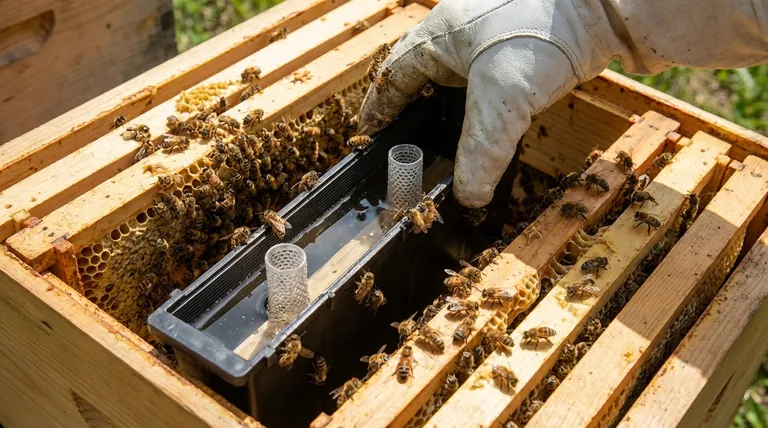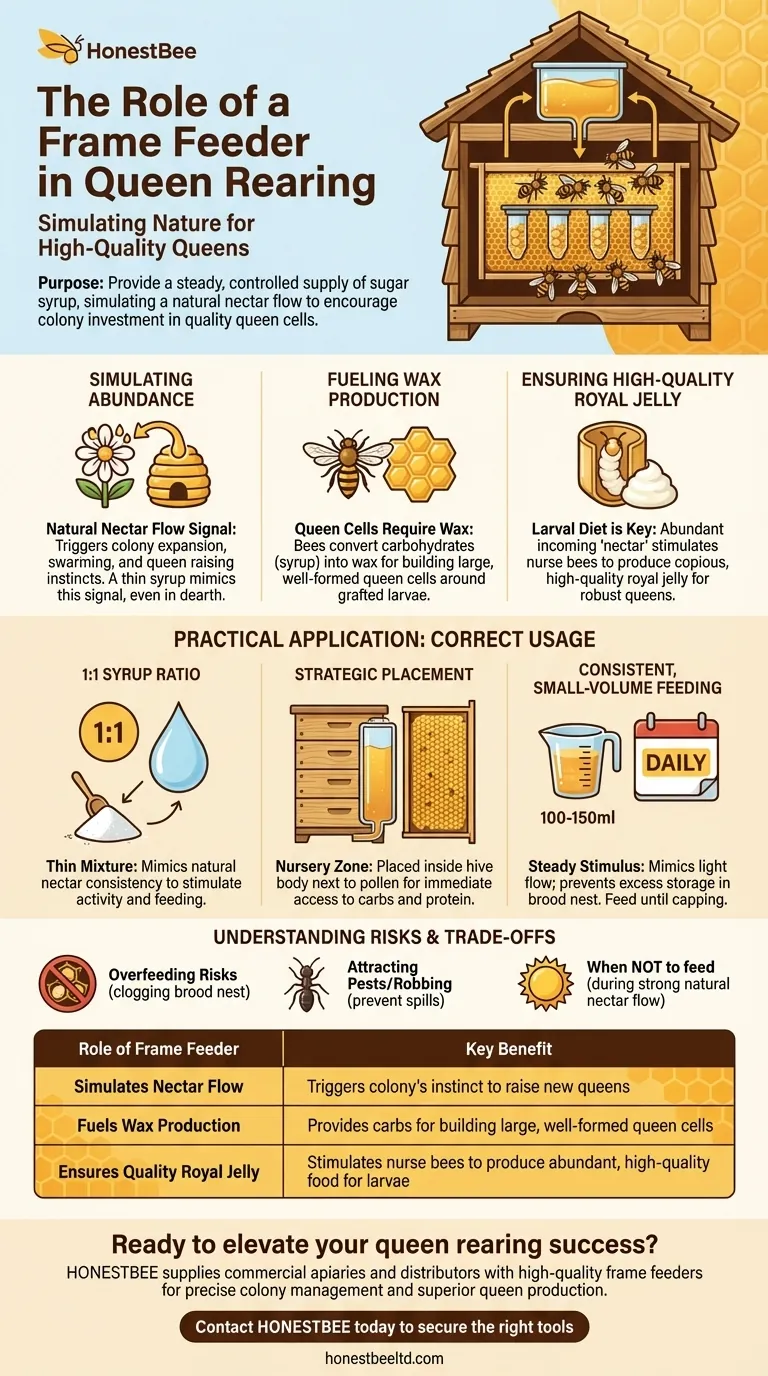In the context of queen rearing, a frame feeder is a specialized internal hive feeder used to provide a steady, controlled supply of sugar syrup. This simulates a natural nectar flow, which is a critical environmental trigger that encourages the colony to accept grafted larvae and invest the maximum resources into building high-quality queen cells.
The core purpose of a frame feeder in queen rearing is not just to feed the bees, but to manipulate the colony's perception of its environment. By simulating a nectar flow, you convince the hive it has the resources to successfully raise new, high-quality queens.

The Critical Role of Nectar Flow in Queen Rearing
Success in queen rearing hinges on understanding bee biology. A colony's willingness to invest in new queens is directly tied to its perception of resource abundance.
Simulating Abundance
A natural nectar flow is the ultimate signal of abundance for a honey bee colony.
When nectar is plentiful, bees are biologically programmed to expand, swarm, and raise new queens. A frame feeder filled with thin syrup mimics this signal, triggering the same instinctual behaviors even when the external environment is lacking.
Fueling Wax Production
Queen cells are large, complex structures that require a significant amount of new beeswax.
Bees consume carbohydrates (nectar or syrup) and convert it into wax through their wax glands. Providing a steady supply of syrup directly fuels this production, ensuring nurse bees can draw out large, well-formed queen cells around the grafted larvae.
Ensuring High-Quality Royal Jelly
The quality of a queen is determined by the diet she receives as a larva.
A larva destined to become a queen is fed exclusively on a protein-rich substance called royal jelly. An abundance of incoming "nectar" stimulates the nurse bees' glands to produce copious amounts of high-quality royal jelly, ensuring the developing queens are well-fed and robust.
Practical Application: Using the Feeder Correctly
Proper technique is essential. The goal is to create a gentle, continuous stimulus, not to simply dump large quantities of food into the hive.
The Right Syrup Ratio (1:1)
The syrup should be a thin 1:1 mixture (by weight or volume) of sugar and water.
This ratio closely mimics the consistency of natural nectar. It acts as a stimulant for colony activity and feeding, whereas a thicker syrup (like 2:1) is typically used for building winter stores and is less effective for this purpose.
Strategic Placement
The feeder should be placed inside the hive body, directly next to a frame of pollen.
This creates a "nursery zone." Nurse bees have immediate access to both carbohydrates (syrup) and protein (pollen), the two essential food components needed to produce royal jelly and care for the developing queen larvae.
Consistent, Small-Volume Feeding
The colony should receive a small amount of syrup—typically 100-150ml—every day.
This mimics a light but steady nectar flow. This consistent stimulus keeps the queen-rearing impulse active without causing the bees to store the excess syrup in the brood nest, which would be counterproductive. Feeding should continue until the queen cells are capped.
Understanding the Risks and Trade-offs
While essential, improper feeding can create significant problems. Knowing the potential pitfalls is key to avoiding them.
Risk of Overfeeding
Giving the colony too much syrup at once can backfire. The bees may begin storing it in the very cells you want them to use for raising queens or laying eggs, clogging the brood nest.
Attracting Pests and Robbing
The smell of sugar syrup can attract ants and other pests. More seriously, it can trigger "robbing," where bees from stronger, nearby hives invade the weaker queen-rearing colony to steal its resources. Internal frame feeders help minimize this, but care must be taken to prevent spills.
When Not to Feed
If you are performing queen rearing during a strong, natural nectar flow, supplemental feeding is unnecessary and potentially harmful. The natural environment is already providing the ideal stimulus.
Making the Right Choice for Your Goal
Using a frame feeder is a deliberate act of resource management. Your specific goal will dictate your focus.
- If your primary focus is maximizing cell acceptance: Your main goal is to use consistent, light feeding to simulate a nectar flow and encourage the colony to immediately accept the grafts.
- If your primary focus is ensuring high queen quality: Your main goal is to provide the necessary fuel for abundant, high-quality royal jelly production throughout the entire larval development period.
- If your primary focus is avoiding common problems: Your main goal is to feed precise amounts daily to prevent clogging the brood nest and to be vigilant about preventing spills that could attract robbers.
Ultimately, the frame feeder is a tool that gives the beekeeper precise control over the colony's most critical impulse.
Summary Table:
| Role of Frame Feeder | Key Benefit |
|---|---|
| Simulates Nectar Flow | Triggers colony's instinct to raise new queens |
| Fuels Wax Production | Provides carbs for building large, well-formed queen cells |
| Ensures Quality Royal Jelly | Stimulates nurse bees to produce abundant, high-quality food for larvae |
Ready to elevate your queen rearing success?
HONESTBEE supplies commercial apiaries and beekeeping equipment distributors with the high-quality, durable frame feeders and other essential supplies needed for precise colony management. Our wholesale-focused operations ensure you get the reliable equipment required to simulate optimal conditions and produce superior queens.
Contact HONESTBEE today to discuss your specific needs and secure the right tools for your operation.
Visual Guide

Related Products
- Professional In-Hive Frame Bee Feeder by HONESTBEE
- 3.5L Plastic Beehive Frame Feeder Deep Frame Water Feeder for In Hive Use
- In-Hive Dual Compartment Frame Bee Feeder for Targeted Colony Nutrition
- Boardman Entrance Bee Feeder Durable Galvanized Steel and Wood Construction for Beekeeping
- Professional Hive Front Entrance Bee Feeder
People Also Ask
- What is a frame feeder? A High-Capacity, Secure In-Hive Feeding Solution
- What are frame feeders, and what are their advantages? Essential for Cold Weather & Efficient Feeding
- What is a frame feeder and how does it work? An Efficient In-Hive Feeding Solution
- What are the types of internal feeders used in beekeeping? Optimize Your Hive's Nutrition Strategy
- How do I keep bees from drowning in my frame feeder? Essential Tips for a Safe Hive



















